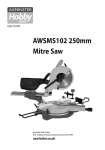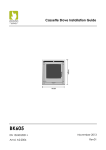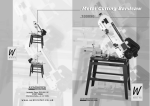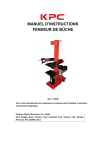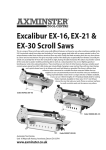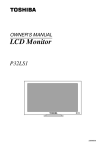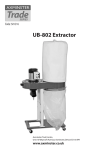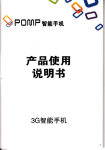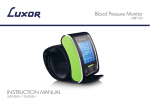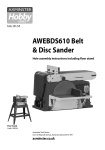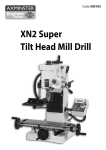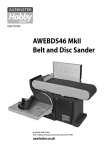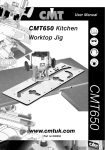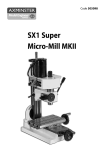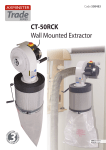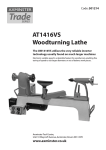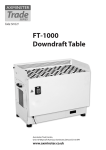Download Ax-White Manual Temp - Axminster Power Tool Centre
Transcript
Code 501255 AW130BD2 Belt and Disc Sander Axminster Tool Centre, Unit 10 Weycroft Avenue, Axminster, Devon EX13 5PH axminster.co.uk Index of Contents Page No Index of Contents Declaration of Conformity What’s in the Box General Instructions for 230V Machines Specific to Sanding Machines Specification Assembly Setting Up Illustration and Parts Description Sanding Configurations Changing the Abrasive Belt/Disc Maintenance Trouble Shooting Wiring Diagram Parts Breakdown Parts List Notes 02 02 03-04 05 06-07 07 08-09-10 10-11-12-13 14-15 16 17 18 18 19 20-21 22 23 Declaration of Conformity Copied from CE Certificate The undersigned, Qing Huang authorised by Jiangsu Jinfeida Power Tools Co., Ltd. Xiejia Town, 225644 Gaoyou City, Jiangsu Province, PEPLE’S REPUBLIC OF CHINA declares that this product manufactured by Jiangsu Jinfeida Power Tools Co. is in compliance with the following standards or standardisation documents in accordance with Council Directives. EN 61029-1:2009 Model number (MM411, PP300-PB) Belt sander symbols below advise that you follow the correct Warning The safety procedures when using this machine. Fully read manual and safety instructions before use 02 Ear protection should be worn Eye protection should be worn Dust mask should be worn HAZARD Motor gets hot What’s in the Box Model Number: 1 off: AW130BD2 Belt and Disc Sander MM411, PP300-PB A (Sanding Disc & Belt Assembled) 1 off: Dust Extraction Moulding 1 off: Sanding Disc Cast Iron Table C 1 off: Sanding Belt Cast Iron Table D B Bag 1 Containing: 1 off: Mitre Fence E 4 off: Rubber Feet F 1 off: M8 x 20mm Large Lift and Shift Handle G 2 off: M6 x 15mm Small Lift and Shift Handles H 1 off: M8 Washer I 2 off: M6 Washer J 4 off: M4 x 10mm Phillips Screws with Washers (Not Shown) K Bag 2 Containing: 1 off: 4mm Hex Key L 1 off: 3mm Hex Key M 1 off: Instruction Manual 1 off: Guarantee Card A 03 02 Continues Over.... What’s in the Box G B H L M D E C I J F Having opened the box, remove the top packaging and lift the machine out and place upon a clear flat surface, taking care not to trap or pinch the power cable under the chassis. Remove the remaining items from the box and place safely aside. HAVING UNPACKED YOUR SANDER AND ITS VARIOUS COMPONENTS, IF YOU DO NOT WISH TO RETAIN THE PACKAGING PLEASE TAKE IT TO A RECYCLING CENTRE. ! 04 NOTE: Please read the Instruction Manual prior to using your new machine; as well as the operating procedures for your new machine, there are numerous hints and tips to help you to use the machine safely and to maintain its efficiency and prolong its life. Keep this Instruction Manual readily accessible for any others who may also be required to use the machine. General Instructions for 230V Machines Good Working Practices/Safety The following suggestions will enable you to observe good working practices, keep yourself and fellow workers safe and maintain your tools and equipment in good working order. ! WARNING!! KEEP TOOLS AND EQUIPMENT OUT OF THE REACH OF YOUNG CHILDREN Mains Powered Tools (General) Disc & Belt Sander Primary Precautions These machines are supplied with a moulded 13 Amp. plug and 3 core power cable. Before using the tool inspect the cable and the plug to make sure that neither are damaged. If any damage is visible have the tool inspected/repaired by a suitably qualified person. If it is necessary to replace the plug, it is preferable to use an ‘unbreakable’ type that will resist damage on site. Only use a 13 Amp plug, make sure the cable clamp is tightened securely. Fuse at 13 Amp. It is also good practice to use switched outlets. If extension leads are to be used, carry out the same safety checks on them, and ensure that they are correctly rated to safely supply the current that is required for your machine. This machine is intended primarily for inside/workshop usage. Work Place/Environment Always mount the machine on a flat, level stable surface. There are several methods of achieving this; bolting the machine directly to a ‘good solid workbench’; bolting the machine to a sturdy base board that can be clamped to the ‘good solid workbench’; create an independent entity by bolting the machine to its own stand. However you mount your machine, make sure it is fastened down and stable before use. Paper belts and discs do not respond well to wet or damp conditions. In the worst case the adhesives holding the belt and the abrasive fail completely, the belts fall apart and the abrasive becomes a soggy mess against the edge of your workpiece. Try to keep the machine in a reasonably dry, warm environment. If this is not possible, or if the machine is to remain unused for some time, at least remove the belt, put in a ‘plastic’ bag and store in a warm dry place. With regard to the disc, this advice is on practical if you have upgraded to a Velcro fastening method. Also ensure that sparebelts/discs arer not stored in dammp conditions. Keep the work area as uncluttered as is practical; this includes personnel as well as material. ! UNDER NO CIRCUMSTANCES SHOULD CHILDREN BE ALLOWED IN WORK AREA 05 Specific to Sanding Machines ! Warning! The sanding disc cannot be declutched from the belt and vice versa, both functions are active when the machine is running. Remember this, and do not leave loose objects of any description on the machine if it is going to be used. Once the sander is mounted, carry out any setting operations and remove all tools used in the setting operations (if any) and place safely out of the way. If you are working long lengths of material arrange for extra support beyond the boundary of the machine, and check you have sufficient room to manoeuvre the material through all the operations you will wish to carry out. It is good practice to leave the machine unplugged until work is about to commence; also make sure to unplug the machine when it is not in use. Always disconnect by pulling on the plug body and not the cable. After fitting a new sanding disc, it is good practice to lightly sand across the left side of the disc with a reasonable sized (20mm x 50mm) piece of timber to make sure the sanding disc is correctly ‘seated’ on the disc. The sanding action will press the sanding disc firmly back against the disc itself. It is not good practice to wear gloves whilst sanding as you tend to lose the ‘feel’ of the workpiece/sander contact, but obviously this removes the safety barrier between your fingers and the sanding surface. Remain focused and exercise caution whilst sanding. DO NOT sand very small pieces of work with bare hands; try to construct some form of holder. Make sure you are comfortable before you start work, balanced, not reaching etc. If the work you are carrying out is liable to generate excessive grit or dust or chips wear the appropriate safety clothing, goggles, masks etc. If the work operation appears to be excessively noisy wear ear-defenders. If you wear your hair in a long style wearing a cap, safety helmet, hairnet, even a sweatband, will minimise the possibility of your hair being caught up in the rotating parts of the machine Likewise, consideration should be given to the removal of rings and wristwatches if these are liable to be a ‘snag’ hazard. Do not work with cutting/abrasive tools of any description if you are tired, your attention is wandering or you are being subjected to distraction. Do not use the machine within the designated safety areas of flammable liquid stores or in areas where there may be volatile gases. Check that sanding surfaces are still sufficiently abrasive to carry out the work you intend. Sanding belt cleaning sticks are an efficient method of prolonging the life of the belts and discs and will also maintain their operating performance. Check that the belts or discs are undamaged; torn edges can pick up on the workpiece and will cause the medium to tear, often very rapidly with accompanying sharp flapping edges. Always offer the workpiece to the belt/disc so that the motion carries the work against the restraining surface i.e. the work stop or the table (use the left hand side of the disc). 06 Continues Over.... Specific to Sanding Machines Do not press too heavily against the sanding surface, all this will do is slow the sander down. Remember, sanders work by removing small particles of material quickly and heavy pressure works adversely to the cutting process. Further, it will accelerate the rate of ‘clogging’ of the abrasive surfaces, rendering the machine less efficient. If you are attempting to sand inside curves (over the ‘tracking drum’) do not press at all, other than to keep the workpiece in contact with the surface, any pressure could upset the tracking geometry. As there is no cushioning effect to the belt passing around the drum, expect an added vibration and compensate for it. Sanding of certain types of timber may make the fitting of dust extraction mandatory in order to comply with the directives of the HSE. However, even if it is not mandatory, it is strongly recommended that you consider fitting dust extraction. It will certainly reduce the level of dust and grit, and as it helps to remove the waste quicker will certainly prolong the longevity of the abrasive. Above all, OBSERVE…. make sure you know what is happening around you, and USE YOUR COMMON SENSE. Specification Model Product Code Rating Power Belt Speed Belt Size Diameter of Disc Table Size Belt Table Size Disc Dust Extraction Outlet Overall L x W x H Weight AW130BD2 501255 Hobby 190W 14.3m/min 25 x 760mm 125mm 125 x 125mm 88 x 184mm 2 x 45mm 370 x 300 x 380mm 7kg 07 Assembly Rubber Feet and Sanding Belt Table Locate the four rubber feet (F); turn the belt and disc sander (A) on it’s side and insert a rubber foot into each of the four pre-drilled holes in the base plate (See fig 1). Stand the sander upright. Fig 1 Fig 2 D F Insert the rubber foot into the pre-drilled hole in the base plate Lower the sanding belt table (D) in position Locate the sanding belt table (D), M8 x 20mm lift and shift handle (G) and M8 washer (I). The sanding belt table (D) has a machined cutout slot; slide the belt into the slot until the clamping bracket is flush against the frame. Line up the machined slot in the bracket with the pre-drilled tappered hole in the casting, using the M8 washer (I) and M8 x 20mm lift and shift handle (G). Clamp the table in position (See figs 2-3 and 4). NOTE: You my find it easier if you remove the lift and shift handle (G) and screw the clamping rod in finger tight, then replace the handle (See fig 3) G Fig 3 Fig 4 I Lightly screw the clamping rod in until it is finger tight ! Tighten the lift and shift handle to clamp the table (D) in position NOTE: When tilting the table, it should be adjusted so that the gap between the belt and the table is no larger than 1.5mm (1/16"). A gap greater than this could cause small workpieces to slip down between the belt and table. 08 Assembly Dust Extraction Moulding Fig 5 Fig 6 B K Remove the four Phillips screws (K) and place safely aside Dust extraction moulding (B) assembled Using a Phillips screwdriver remove the four M4 x 10mm pan head Phillips screws and washers (K), place safely aside (See fig 5). Locate the dust extraction moulding (B), line up the four holes in the moulding with the tapped holes in the casting and secure using the Phillips screws and washers (K) you removed earlier (See fig 6). Sanding Disc Table ‘L’ Shaped slot Fig 7 Fig 8 C Pin Locate the sanding disc table (C), M6 x 15mm lift and shift handles (H) and M6 washers (J). Line up the table (C) pins with the machined L shaped slots on either side of the sanding disc, push the table in until fully home (See figs 7-8). Remove the handles (H) and place safely aside. Place an M6 washer (J) over each thread, slot the rods through the machined slots in the table (C) and screw them into the pre-drilled hole until finger tight. Replace the handle and tighten (See figs 9-10). Fig 10 Fig 11 J H 09 Assembly Mitre Fence Fig 12 Fig 13 E C ‘T’ slot Slide the mitre fence (E) into the table ‘T’ slot Locate the mitre fence (E) and slot it into the table (C) ‘T’ slot (See figs 12-13). Setting Up Table Adjustment ! NOTE: Before using your belt and disc sander you need to check that the tables are perpendicular by using a 90˚ square. Place a 90˚ square on the sanding disc table (C) and check that the table is perpendicular to the sanding disc. If it requires adjustment loosen the two lift and shift handles (H), adjust until correct and re-tighten the two handles (See figs 14-15). Check that the scale pointer is set to 0˚ and adjust if required (See fig 16). Reposition the square and check the mitre fence (E) is perpendicular to the disc and adjust if required. Reset the pointer on the mitre fence to 0˚ (See fig 17). Fig 14 Fig 15 C H E 10 Setting Up Pointer Scale Fig 16 Fig 17 Pointer Fig 18 Fig 19 Adjust the table (D) until it is perpendicular to the belt 90˚ Square perpendicular to sanding belt Place the square on the table (D), up against the belt; check that the table is perpendicular to the sanding belt. If it requires adjustment loosen the lift and shift handle (G), adjust until correct and re-tighten the handle (See figs 18-19). ! NOTE: For fine adjustments adjust the grub screw to the rear of the table, when correct adjust the nut beneath the table to clamp the grub screw in position (See figs 20-21). Hex key Fig 20 Fig 21 Grub screw Using a Hex key, fine adjust the table if the square still does not line up correctly The clamping nut beneath the table is to lock the grub screw in position 11 Setting Up Tracking the Belt To check the sanding belt is tracking properly you first have to remove the side cover, follow the instruction below: First undo the two Phillips screws (a) and (b) as shown in figs 22-23 and place the screws safely aside. Undo and remove the clamping knob (c) below the guard, remove the belt access cover (d) and place safely aside (See figs 24-25). a Fig 22 Fig 23 Remove the Phillips screw b d Fig 24 Fig 25 c With the cover (d) removed, turn the tracking knob (e) clockwise to track the belt to the right or anti-clockwise for left, until the belt is tracking evenly (See figs 26-26a). Replace the cover (d) as described above but in reverse. e ! NOTE: DO NOT turn the tracking knob too aggressively, the adjustment only needs to be very slight. 12 Fig 26 Fig 26a Setting Up Adjusting the Platen The Platen (f) should be adjusted so that it almost touches the back of the abrasive belt. If it requires adjustment loosen the two caphead screws (g) that secure it to the frame and adjust until correct. Re-tighten the screws (See figs 27-28). Fig 27 Fig 28 f g Loosen the platen (F) and adjust it unit it almost touches the back of the belt Loosen the two caphead screws (g) to adjust the platen Your belt and disc sander is now ready. Check that all fixings are secure before operating the machine. ! CONNECT THE SANDER TO THE MAINS SUPPLY Remove all tools away for the machine, Switch on, wait until the machine has reached full speed and check that the belt is tracking properly. If not, switch off, wait for the machine to come to a complete stop, disconnect the sander and go to page 11 for “Tracking the Belt”. Reconnect, switch on and check again. If everything is fine, switch off and wait until the machine has come to a complete stop. ! DISCONNECT THE SANDER FROM THE MAINS SUPPLY Dust Extraction The dust extraction mouldings (h) have a 45mm outlets, (See figs 29-30) Insert a jubilee clip over the hose and insert it over the outlet and clamp in place. Alternately, if you have a vacuum cleaner with the same diameter holes insert it over the outlet as before, it should be a snug fit. Fig 29 Fig 30 h h 13 Illustration and Parts Description Belt guard A Abrasive belt Tracking knob Platen ON/OFF Control box D Abrasive disc C G H B E F Scale Pointer Pointer rest screw 14 A) AW130BD2 Belt and Disc Sander E) Mitre Fence B) Dust Extraction Moulding F) Rubber Feet C) Sanding Disc Cast Iron Table G) M8 x 20mm Large Lift & Shift Handle D) Sanding Belt Cast Iron Table H) M6 x 15mm Small Lift & Shift Handle Illustration and Parts Description Belt access cover Disc guard Clamping knob Platen Dust extraction outlet Chassis Dust extraction outlet Off On On/Off Control box Grub screw for leveling the table 15 Sanding Configurations Disc Sanding Belt Sanding 16 Angle Sanding Changing the Abrasive Belt/Disc Sanding Belt ! DISCONNECT THE SANDER FROM THE MAINS SUPPLY Remove the belt access cover as described on page 11 Tracking the Belt, and place safely aside. While holding the belt, push in the tracking knob, thus releasing the tension on the belt and remove the abrasive belt (See figs 3132). Fig 31 D Fig 32 Check the new belt for any signs of damage; fit the new belt by sliding it through the table (D) cutout and fit it over the three pulleys then release the tracking knob, putting tension back on. Replace the access cover (d); reconnect the sander to the mains, turn on and check the belt is tracking correctly. If not remove the cover and go to page 11 for Tracking the Belt. Replace the cover reconnect to the mains and check again. Sanding Disc ! DISCONNECT THE SANDER FROM THE MAINS SUPPLY Remove the lift and shift handle (H), sanding disc table (C), dust extraction moulding (B) and place safely aside. Lift the edge of the disc and, gripping firmly, peel the disc away from the plate; turning the plate as required to free the entire disc (See fig 33). Remove and throw away. Remove any patches of abrahesive that have stuck to the disc and render the plate CLEAN. Fig 33 Peel the cover from the adhesive surface and apply CAREFULLY to the flat surface of the cast iron disc. Place a piece of cloth in your hand or wear a glove, to firmly press the abrasive to the disc, it will be reinforced by a gentle sanding action across the face when you first use the new sanding disc. Replace the extraction moulding (B), sanding disc table (C) and lift and shift handles (F). 17 Maintenance ! DISCONNECT THE SANDER FROM THE MAINS SUPPLY There is very little mechanical maintenance that can be carried out on the machine. Most prudent maintenance is preventative and concerned with keeping the machine clean. 1. Remove the access belt cover and check there is no dust or resin build up on the pulleys or at the edges of the platen. 2. At reasonable intervals, inspect and remove all dust/resin build ups, and blow the motor clean. 3. Remove the dust extraction moulding (B), remove any dust or resin build up and clean thoroughly. Trouble Shooting PROBLEM Motor will not run 18 POSSIBLE CAUSE REMEDY 1. Defective or broken “ON -OFF” switch 2. Defective or damaged switch cord 3. Defective or damaged switch relay 4. Burned out motor 5. Blown fuse 1-3. Replace all broken or defective parts before using the sander Machine slows down while sanding 1. Applying to much pressure to workpiece 1. Apply less pressure to sanding surface Sanding belt runs off pulleys 1. Belt NOT tracking properly 1. Adjust tracking. See page 11 on how to track the belt Wood burns while sanding 1. Sanding disc or belt is worn 2. Excessive pressure being applied to workpiece 1. Replace the disc or belt 4. Contact Axminster Tool Centre on 0800 371822 and asked to be transferred to the “Technical Sales” Department 2. Reduce pressure being applied to workpiece Wiring Diagram 19 Parts Breakdown 20 Parts Breakdown 21 Parts List 22 Notes 23 Please dispose of packaging for the product in a responsible manner. It is suitable for recycling. Help to protect the environment, take the packaging to the local recycling centre and place into the appropriate recycling bin. Only for EU countries Do not dispose of electric tools together with household waste material. In observance of European Directive 2002/96/EC on waste electrical and electronic equipment and its implementation in accordance with national law, electric tools that have reached the end of their life must be collected separately and returned to an environmentally compatible recycling facility.
























